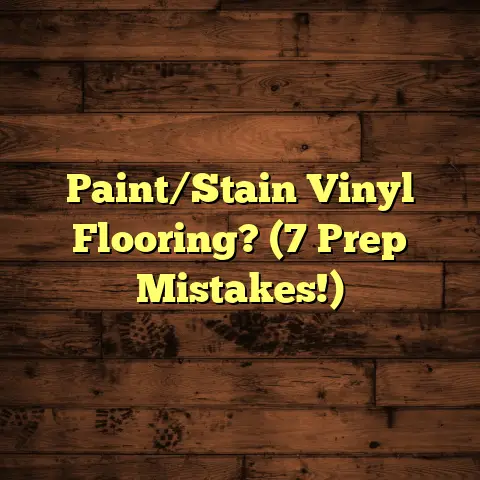How Do You Stain Your Concrete Floor? (Explained)
Imagine walking into a space that feels both inviting and unique, where the floor draws your attention with its rich colors and textures. It’s hard to believe that this beautiful surface started as a plain concrete slab. Staining concrete not only enhances its appearance but can also transform the entire ambiance of a room or outdoor area. Having stained many concrete floors over my career, I’ve learned valuable techniques, faced challenges, and discovered how to achieve stunning results.
Understanding Concrete Staining
Concrete staining is a method used to enhance the surface of concrete by applying a pigment that creates an appealing aesthetic effect. This process not only beautifies the floor but also protects it from wear and tear. The two primary types of stains available are acid-based stains and water-based stains, each offering unique advantages.
Acid-Based Stains:
Acid stains use a chemical reaction with the minerals in the concrete to produce a variegated color effect. They are known for their ability to create deep, rich colors that resemble natural stone. However, they come with strict safety precautions due to their toxic nature.
Water-Based Stains:
In contrast, water-based stains are easier to work with, have less odor, and offer a wider range of colors. They penetrate the surface but do not chemically react like acid stains, often requiring more coats to achieve a desired color intensity.
Preparation for Staining
Proper preparation of the concrete surface is crucial for successful staining. I’ve learned that without thorough preparation, the stain may not adhere correctly, leading to uneven coloring.
Assessing the Concrete Surface
Before starting any project, I assess the condition of the concrete. Look for cracks, stains, or any signs of damage. If the surface is contaminated with oils or sealers, it will require special attention.
Cleaning Methods and Tools
Cleaning is vital in preparing the surface. I typically use a combination of a degreaser and a pressure washer to remove dirt, grease, and debris. For stubborn spots, scrubbing with a stiff-bristled brush helps ensure all contaminants are removed.
Filling Cracks and Imperfections
After cleaning, I inspect the concrete closely for cracks or holes. I fill these imperfections with a concrete patching compound and allow it to cure according to the manufacturer’s instructions.
Testing the Surface
Before applying stain to the entire area, I conduct a small test on an inconspicuous spot. This test reveals how the stain will interact with the concrete and helps me adjust my technique if necessary.
Planning the Project
Once I’ve prepared the surface, I turn my attention to planning the project. Using FloorTally has been instrumental in this phase. The platform allows me to input different variables and generate realistic cost estimates that include materials, labor, and potential waste.
Budgeting for Materials and Labor
For my projects, I create a detailed budget that outlines all expenses. This includes not just the cost of stain but also tools like sprayers, brushes, protective gear, and sealers. Typically, I allocate around $400-$800 for a standard-sized room (about 400 square feet), depending on whether I choose acid or water-based stains.
Choosing the Right Stain Color and Finish
Choosing a stain color can be daunting due to the variety available. I encourage clients to consider their overall décor and personal style when selecting colors. FloorTally’s visualization tools help my clients see how different colors will look in their space before making a final decision.
The Staining Process
With everything planned out, it’s time to begin staining! The process can be broken down into several detailed steps.
Detailed Application Steps for Acid Stain
- Mixing the Stain:
I start by thoroughly mixing the acid stain according to the manufacturer’s instructions. - Application:
Using a garden sprayer or a mop applicator, I apply the stain evenly across the floor. For large areas, I work in sections to ensure an even application. - Waiting Period:
After applying the first coat, I wait approximately 4-6 hours for it to dry before assessing if a second coat is needed. - Neutralizing:
Once satisfied with the color, I neutralize the acid by scrubbing with a mixture of baking soda and water. - Sealing:
Finally, after allowing it to dry completely, I apply a high-quality sealer to protect the finish.
Detailed Application Steps for Water-Based Stain
- Preparation:
Just like acid stains, water-based stains require thorough mixing before application. - Application:
I use a paint roller or sprayer to apply a thin coat over the floor. Water-based stains dry faster than acid stains, so I make sure to work quickly. - Building Layers:
To achieve richer colors, I often apply multiple thin coats rather than one heavy coat. - Sealing:
Similar to acid stains, I finish with a sealer once the last coat is dry.
Post-Staining Care
After staining comes the essential task of caring for your newly stained floor.
Applying Sealers: Types and Benefits
There are various types of sealers available such as acrylics, epoxies, and polyurethanes. Each offers different levels of gloss and durability:
- Acrylic Sealers: Easy to apply but may require more frequent reapplication.
- Epoxy Sealers: Provide high durability but can be more complex to apply.
- Polyurethane Sealers: Offer excellent protection and durability but may have higher costs.
I generally prefer using polyurethane sealers for their longevity and ability to withstand heavy foot traffic.
Recommended Maintenance for Stained Floors
Maintaining stained concrete floors is relatively simple. Regular sweeping or vacuuming keeps dirt at bay, while damp mopping with a mild cleaner helps preserve the finish. Avoid using harsh chemicals that can degrade the sealer over time.
Addressing Common Issues After Staining
Sometimes issues arise after staining, such as discoloration or peeling sealers. If discoloration occurs, it may indicate an uneven application or contamination on the surface prior to staining. Peeling sealer can result from improper curing times or applying too thickly.
Personal Experiences and Challenges
Throughout my career as a flooring contractor, I’ve encountered numerous projects that tested my skills and knowledge about concrete staining.
Specific Projects I’ve Completed
One memorable project was staining a large outdoor patio at a local café. The client wanted a rustic look that would complement their wooden furnishings. After discussing options, we settled on an earthy brown acid stain that would harmonize well with their theme.
I prepared the 1,200-square-foot patio over two days, ensuring all surfaces were clean and ready for staining. The application took another day due to its size but produced stunning results that captured everyone’s attention.
Success Stories and Lessons Learned
This project taught me valuable lessons about patience and attention to detail. The final reveal was met with praise from both the client and their customers. However, it also highlighted how important it is to communicate expectations clearly with clients; they need to understand that some variations in color may occur due to differences in concrete composition.
Troubleshooting Issues Encountered
Not every project goes smoothly—I’ve had my fair share of challenges! One instance involved staining an interior floor where moisture trapped beneath caused bubbling in some areas after sealing.
To address this issue, I had to strip the sealer back completely and allow the floor to dry thoroughly before reapplying stain and sealer—a process that added several days to our timeline but ultimately resulted in success.
Comparing Staining Options
When choosing between acid-based and water-based stains, understanding their differences can save time and frustration.
Pros and Cons of Different Stains
Acid-Based Stains:
- Pros: Deep color variation; unique marbling effect; highly durable.
- Cons: Requires safety equipment; less flexibility in color choices; longer drying times.
Water-Based Stains:
- Pros: Easy cleanup; lower toxicity; wide range of colors.
- Cons: Generally requires more coats; less depth compared to acid stains; can fade faster if not sealed properly.
Cost Comparison Between Options
In terms of cost, acid-based stains can range from $30-$50 per gallon while water-based options typically range from $20-$40 per gallon. While initial costs differ slightly based on product choice, considering long-term durability is essential when budgeting for your project.
Visual Appeal Differences
In my experience, acid stains tend to create more vibrant designs due to their chemical reaction with concrete minerals; however, water-based stains allow for greater creative freedom with layering colors or patterns.
Advanced Techniques
For those looking to take their concrete staining skills further, there are advanced techniques that can add even more character to your finished product.
Decorative Techniques: Stenciling and Layering Colors
Stenciling allows you to create intricate designs on your stained concrete floors. By applying a stencil during the staining process, you can achieve unique patterns that enhance visual appeal incredibly.
Layering colors can also provide depth—by applying one color followed by another after drying you can create stunning effects reminiscent of natural stone or tiles.
Combining Stains for Unique Effects
To create truly one-of-a-kind floors, consider combining different types of stains or layering techniques—this opens up endless possibilities! For example, using an acid stain followed by a water-based stain adds complexity that captivates viewers’ eyes when they walk into your space.
Conclusion
Staining concrete floors offers an exciting opportunity to breathe new life into otherwise dull surfaces while adding character and charm to any space—be it residential or commercial. Through careful preparation, skillful application techniques learned over years of experience (and aided by tools like FloorTally), you can achieve stunning results that transform your environment entirely.
As you consider diving into this rewarding project yourself—remember: patience is key! Embrace challenges along the way as opportunities for growth; each step leads closer toward achieving your vision—whether it be simply refreshing an existing floor or creating something entirely transformative!
With thoughtful planning combined with creativity at heart—your journey into stained concrete awaits!





